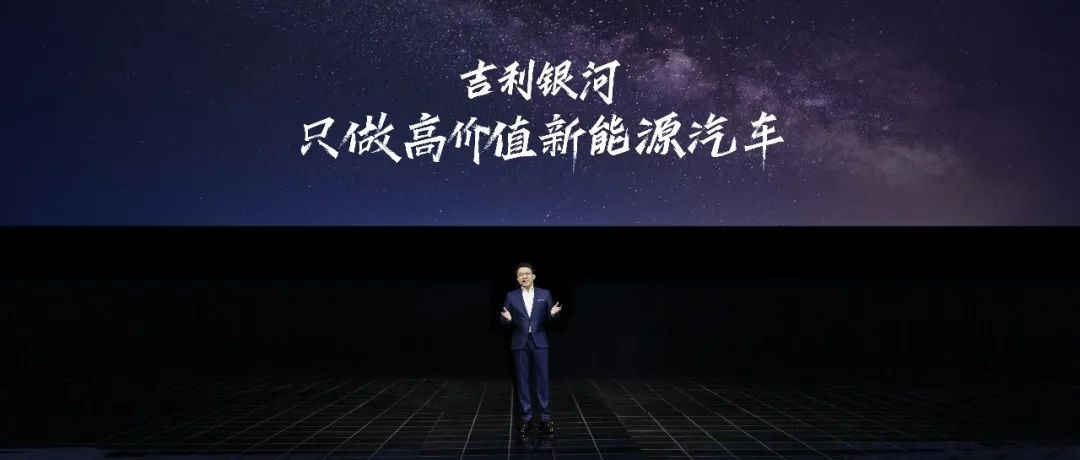Author: Michelin
Recently, the Chinese automotive industry has started a cyber-universe-themed competition. The “initiator” of this trend is Geely Auto, which announced its high-end new energy series, “Geely Galaxy,” on February 16th.
As a well-known player in the domestic automotive industry, Geely Group’s sub-brands and series cars have become too numerous to count. So where does this new Galaxy series fit in? Why would Geely release a new series in 2023 when competition is already so intense? What makes Geely Galaxy stand out from others?
With these speculations in mind, on February 23rd, Geely officially launched the new high-end new energy series “Geely Galaxy,” as well as the first mass-produced model of the Galaxy brand, Geely Galaxy L7, and the Geely Galaxy Intelligent Electric Prototype “Light of Galaxy.”
On the Galaxy series, Geely has invested the most competitive technologies and capabilities in electrification and intelligence. Is Geely’s ambition for electrification and transformation too big for Galaxy to contain?
Why “Galaxy” when there were already “Seven Sons”?
What is the positioning of the Galaxy series? How does it differ from other Geely Group’s subsidiary brands and series cars such as JIKKEI, GeometryAuto, Boyue, Xingtu, and Reeyln? This is probably the first question for many people upon seeing “Geely Galaxy.”
It’s understandable how people might be confused since before the release of the Galxy series, Geely Group already had 11 independent subsidiary brands, with just 7 under the Geely main brand. The release of the Galaxy series has made Geely’s product line even more complicated.
Despite having so many “sons,” Geely’s new energy products have performed well, with sales figures surpassing initial predictions. In 2022, Geely sold approximately 1.433 million units, with 328,700 being new energy cars, accounting for roughly 23% of the total sales. In comparison, BYD, a veteran competitor in the self-owned brand arena, sold 95% electric vehicles out of a total of 1.857 million sold in 2022, and took up the largest slice of the increasing hybrid market. Geely, with its mixed powertrain technology, does not want to miss out on this opportunity.However, within Geely’s brand and model range, except for the pure electric brands Geometry and Jirui, the other hybrid models like the Stars, Boyue, Lynk & Co, and Dihao, find it difficult to erase their fuel-based heritage and to make a significant impact on consumers as new energy vehicles. Only by establishing a new series with an inherent new energy DNA can Geely maximize its electrification tag.
Similarly, there is a gap in the pure electric vehicle market for Geely, with its current gap between Jirui and Geometry being ideal for the biggest family vehicles and the most competitive mainstream markets.
Therefore, the Galaxy Series looks more like Geely is integrating its technological strengths in electrification and intelligence to form a new product line and tackle the new energy market. Silver Galaxy represents Geely’s electrification transition.
The positioning of the Galaxy Series is clear. According to Lin Jie, Geely Automobile Group’s Senior Vice President of the reply in the community, the Galaxy is not an independent brand but a new energy series of Geely. In the future, while Jirui focuses on the high-end market above RMB 300,000, the Galaxy will compete in the mainstream market from RMB 150,000 to RMB 300 000, and Geometry will target the new energy market below RMB 150,000.
As Geely’s new energy product line, the Galaxy Series will consist of two major product sequences: the intelligent pure electric E series and the intelligent power hybrid L series.
Both product sequences are built on the native intelligent electric architecture. Among them, the intelligent power hybrid L series uses Geely Galaxy’s intelligent “power hybrid” architecture, covering A0-B level intelligent power hybrid products, while the intelligent pure electric E series uses Geely Galaxy’s intelligent “pure electric” architecture, covering A-D level intelligent pure electric products.
In terms of the three-electric system, the Galaxy Series is equipped with Geely’s latest “God of War” battery safety system and “Thunderbolt” hybrid 8848 system.
The “God of War” battery safety system integrates the battery structure with the whole vehicle structure, intelligent control, and cloud security protection. It features eight shields, including a patented architecture grid, a cage-type protection for the whole vehicle, safe fast charging, and BMS3.0’s “battery doctor” intelligent control system, to ensure the safety of the battery pack and module systems. Regarding concerns from new energy vehicle users about the safety of the battery in the event of collision impacts or self-ignition, tests on the Galaxy Series show that after being impacted by a 30 km/h collision and towed by a vehicle at 20 km/h, the battery remained intact.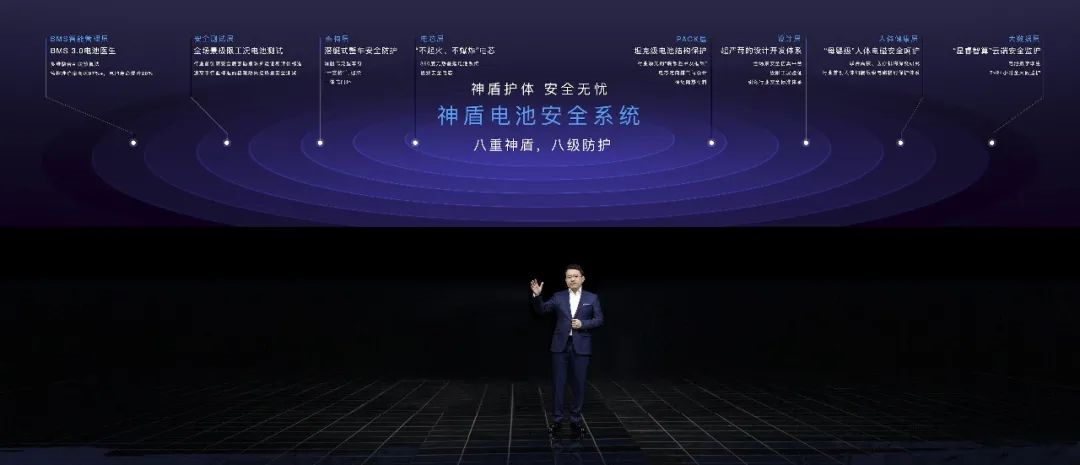
The Galaxy series uses the Thunder Power Hybrid 8848 system. In terms of thermal efficiency, the new generation of Thunder Power Hybrid engine B-Plus, which is equipped by the Thunder Power Hybrid 8848, has a thermal efficiency of 44.26%, and the next generation of Thunder Power Hybrid engine with a thermal efficiency breakthrough of 46% is currently in the validation stage. In terms of performance, the Thunder Power Hybrid 8848 uses “three-gear variable frequency electric drive”, which is the first intelligent electric drive in the world to achieve P1+P2 dual-motor overclocking drive. This series-parallel hybrid structure allows the system to adjust the mode and gear according to different work conditions and states, achieving a transmission efficiency of 97.5%.
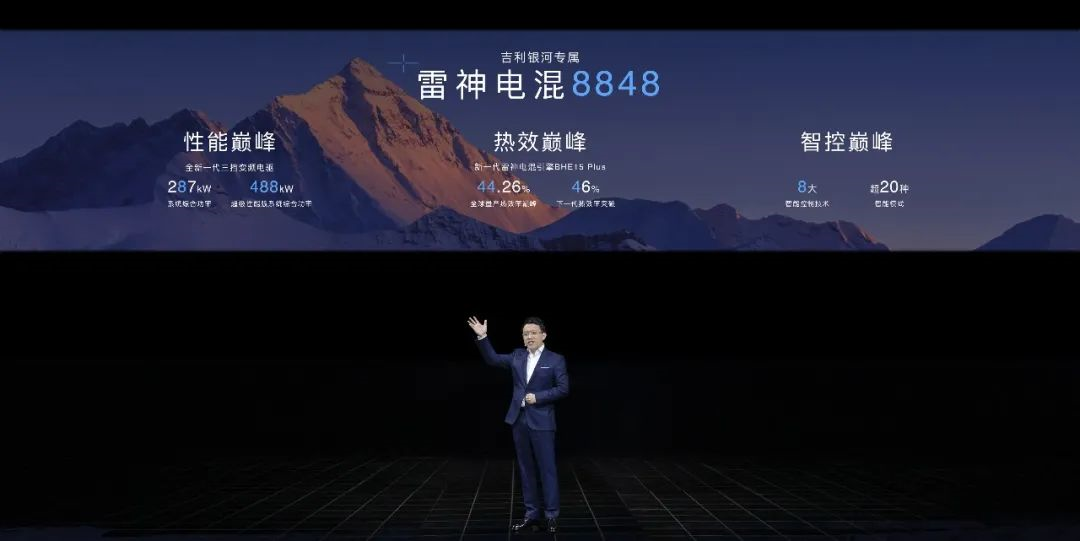
In terms of intelligent control, the Thunder Power Hybrid 8848 features the first predictive performance management system in the industry, which can improve energy efficiency by up to 15%. The newly added intelligent health management function ensures the safe operation of the hybrid system at all times.
In terms of intelligence, the Galaxy series models adopt the elastos H-NOS distributed operating system. Previously, after Meizu joined the Geely family, the advantages of Meizu Flyme’s operating system in UI interaction and mobile-connected car were reflected on the car operating system. The elastos H-NOS provides a visible and responsive interactive experience with millisecond response time.
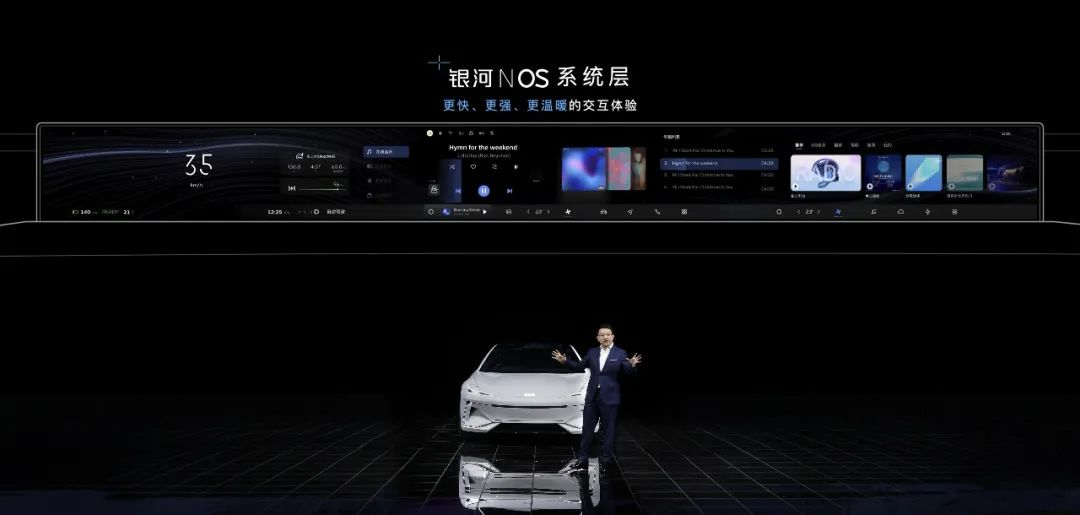
In the future, Geely will soon launch its “Sky-Earth-One” version of the Galaxy smart driving solution through its own satellite layout, which can achieve a global unobstructed positioning capability and enhance the intelligent driving ability of the Galaxy series.
How will the “Galaxy” support Geely’s electric future?
Two weeks ago, when the “Geely Galaxy” series was just announced, many speculated that the Galaxy series would be a high-end brand with a million-level price tag, like the BYD Han. However, for Geely Group, which owns brands such as Volvo and Lotus, the more important task than improving its brand value is to increase sales.At the beginning of the year, Geely set a target for itself: to sell 1.65 million vehicles throughout the year in 2023. In the current market environment, which is not optimistic, achieving a sales growth of more than 15% can only rely on new energy products, especially in the mainstream market of 150,000 to 300,000 RMB.
Therefore, we can see the characteristics of the Galaxy series in product planning: action-oriented and pragmatic.
According to the brand plan, Geely Galaxy will launch seven products in the next two years. The first hybrid product, the Galaxy L7, will be delivered in the second quarter of this year, and the first electric hybrid sedan, the Galaxy L6, will be launched in the third quarter. The first pure electric product, E8, will be delivered in the fourth quarter of this year. This means that the new Galaxy series, which has just been unveiled, will deliver three models within a year.
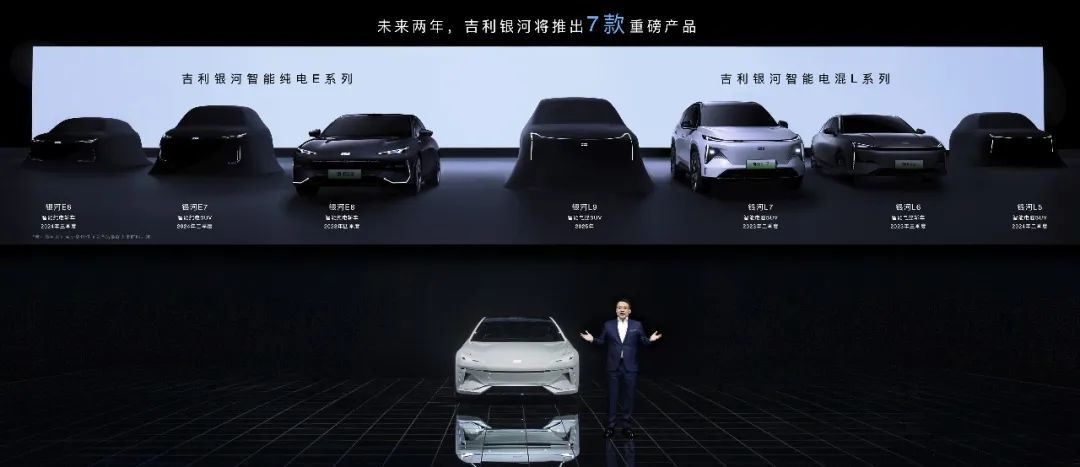
As the first model of the Galaxy series, Geely did not choose the most fiercely competitive and easiest-to-stack large and mid-size SUV, but chose to launch a compact SUV – the Galaxy L7.
As an A-class intelligent electric hybrid SUV, the Galaxy L7 has a body size of 4700mm1905mm1685mm and a wheelbase of 2785mm, which is similar in size to the BYD Song Plus DM-i.

At the press conference, the “independent brand hybrid * Plus” model appeared most frequently in the comparisons with the products of other brands. In the past year, BYD Song Plus DM-i has sold more than 388,000 vehicles, with an average monthly sales of more than 32,000 vehicles. The sales of Song Plus show how huge the potential of the A-class hybrid SUV market is.
 For this reason, there are many star configurations on the Galaxy L7: the Thunderbolt hybrid system with a heating efficiency of up to 44.26%, the CLTC comprehensive range of 1370 kilometers, the 287kW two-wheel drive power, the 488kW super performance version, etc. In terms of intelligentization which was a relatively weak aspect in the A-class cars before, we can see some intelligentization configurations on the Galaxy L7 as the heavyweight ones of the B-class cars: all-time cabin awakening-free function, visible voice recognition, intelligent driving system and so on.
For this reason, there are many star configurations on the Galaxy L7: the Thunderbolt hybrid system with a heating efficiency of up to 44.26%, the CLTC comprehensive range of 1370 kilometers, the 287kW two-wheel drive power, the 488kW super performance version, etc. In terms of intelligentization which was a relatively weak aspect in the A-class cars before, we can see some intelligentization configurations on the Galaxy L7 as the heavyweight ones of the B-class cars: all-time cabin awakening-free function, visible voice recognition, intelligent driving system and so on.
More details about the Galaxy L7 can be found in yesterday’s GeekCar experience video. As mentioned in yesterday’s video, it’s a “mainstream family car“. For mainstream families with more members, responsibilities and needs, they want everything possible but nothing can be abandoned on their limited budget. They also hope that the functions they receive are easy to use. This is the demand of the market for A-class SUVs and it is also the biggest feature of the Galaxy L7: balance. The excellent three-electric system performance and upgraded intelligent configuration make this car without shortcomings.
This strategy is quite similar to that of the fiercely contested intelligent phone market in the past: first, roll up the configuration on high-end models, lift the ceiling with innovative configuration and functions; second, roll up the price, squeeze the water out of the towel; third, lower down the cost of the technology, and deliver the configuration and technology of the high-end models to the mid-end models with larger-scale consumption.
The current price reduction wave in the automobile industry has pushed the whole new energy automobile industry to the second step, while Geely, with its huge size and technological accumulation, has reached the third step with the Galaxy L7. The only variable is that the pricing for the Galaxy L7 is not yet disclosed at the press conference.
Finally,
On the Galaxy series, we can see Geely’s ambitions for transformation: investing in its ace three-electric technology and intelligent capabilities, and efficiently and practically developing products. It has even established a completely new independent channel, adopting two sales models that are similar to those of Extreme Kratos-directly connecting users and agent dealerships in parallel.
 However, amidst Geely’s extensive and complex portfolio of products, whether the Galaxy series can establish itself as a label of Geely New Energy, seize the largest incremental market of the mid-to-high end mainstream market, is the challenge that the Galaxy series will inevitably face in the future.
However, amidst Geely’s extensive and complex portfolio of products, whether the Galaxy series can establish itself as a label of Geely New Energy, seize the largest incremental market of the mid-to-high end mainstream market, is the challenge that the Galaxy series will inevitably face in the future.
This article is a translation by ChatGPT of a Chinese report from 42HOW. If you have any questions about it, please email bd@42how.com.
